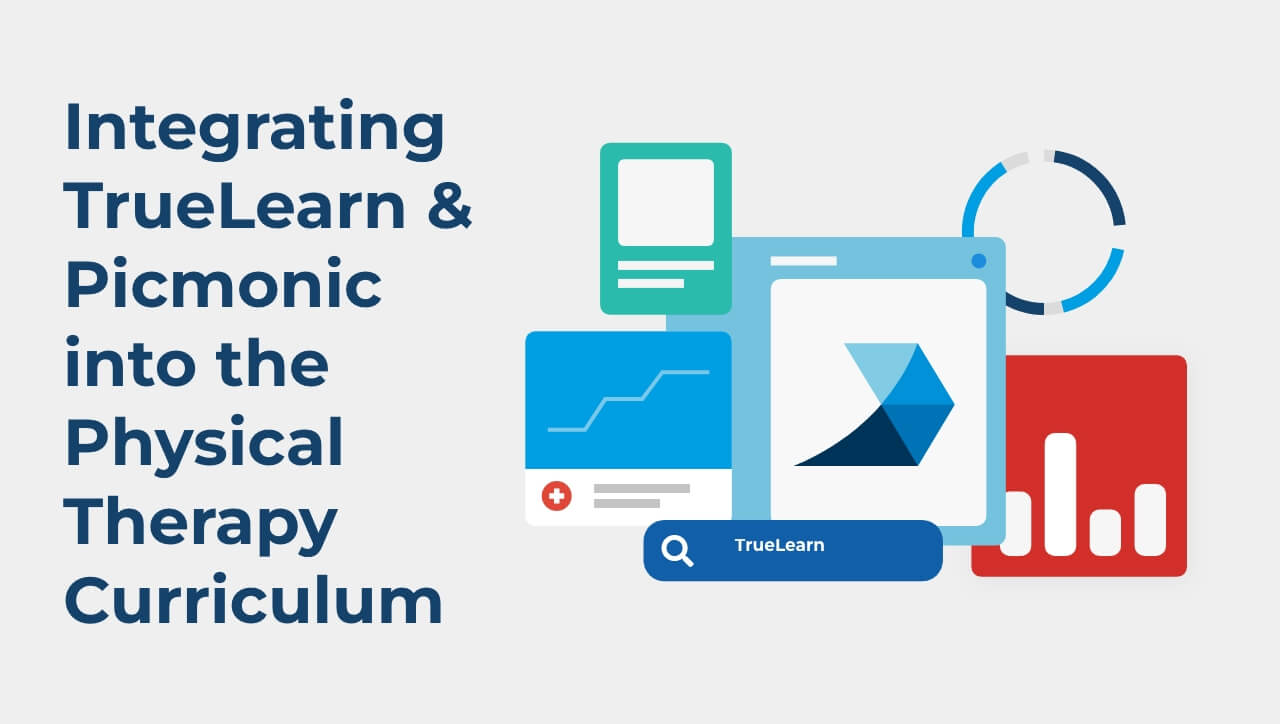Building Clinical Reasoning Skills into Physical Therapy Education
Every physical therapy (PT) program aims to equip students with the knowledge, critical thinking abilities, and decision-making skills needed to pass the NPTE® and become competent physical therapists who can provide safe and effective patient care. However, success in PT goes beyond passing the NPTE®—students must develop clinical reasoning skills to assess clinical findings, apply knowledge in real-world scenarios, and adapt treatment approaches based on patient needs.
Clinical reasoning enables students to gather and analyze patient information, distinguishing between what is relevant and what is not. It allows them to recognize patterns, formulate and test hypotheses, and refine their approach based on outcomes. These skills are essential for making informed clinical decisions, establishing diagnoses, determining prognoses, and creating personalized treatment plans that drive better patient outcomes.1
In this blog, we will delve into the importance of clinical reasoning in PT education, explore effective teaching strategies to strengthen these skills, and highlight ways to support students’ NPTE® readiness and long-term clinical success.
The Importance of Clinical Reasoning Skills in PT Education
Developing strong clinical reasoning skills is a gradual process that requires continuous learning, practice, and reflection. It begins with understanding how to gather, interpret, and apply clinical information—skills that are essential for success both in PT education and future practice.
As students progress through the rigorous PT curriculum, they must integrate complex knowledge with critical thinking to assess patients, make informed decisions, and adapt treatment strategies. Mastering advanced concepts, particularly within the Big 3 systems—Cardiovascular/Pulmonary, Musculoskeletal, and Neuromuscular/Nervous—is just the starting point. Students must also learn to analyze clinical findings, connect information across disciplines, and apply their knowledge to diverse patient scenarios.
Success in PT programs and on the NPTE® requires more than memorization. It demands that students continuously build on their knowledge while refining their clinical reasoning skills throughout their training. This ability to think critically and make informed decisions is what prepares them to deliver effective, efficient, and patient-centered care in clinical practice.
Two Effective Ways to Teach Clinical Reasoning
Now that we understand the importance of clinical reasoning skills and how they require continuous learning, practice, and reflection, let’s explore two effective strategies educators can use to help PT students strengthen these essential skills: research-based learning and self-reflection.
1. Research-Based Learning
One of the most effective ways to develop clinical reasoning is through research-based learning. This approach encourages students to engage with real-world research, analyze findings, and apply their knowledge to clinical scenarios—bridging the gap between theory and practice. By actively evaluating studies and considering their implications in patient care, students learn to think critically and refine their decision-making process.
For example, a 2021 study challenged the assumption that rotator cuff fatty infiltration (FI) and muscle atrophy (MA) negatively impact clinical outcomes2. Researchers examined 108 patients who underwent reverse total shoulder arthroplasty (RTSA) for glenohumeral osteoarthritis (GHOA) with an intact rotator cuff. The results showed no significant difference in postoperative external rotation or clinical outcomes between patients with mild or severe FI. Additionally, the cross-sectional area of each rotator cuff muscle did not significantly correlate with patient-reported outcomes or range of motion (ROM) changes.
This research highlights the importance of challenging assumptions and critically analyzing data—a key aspect of clinical reasoning. However, understanding research findings is just one step. Students must also learn to apply that knowledge in clinical scenarios to strengthen their reasoning skills.
Evidence-based learning strategies such as practice retrieval—the process of actively recalling information to reinforce learning—can help solidify this application. Instead of passively reviewing material, students are encouraged to engage with the content by answering low-stakes quizzes, case-based scenarios, or NPTE®-style questions that reflect clinical presentations. This approach not only helps consolidate knowledge into long-term memory but also promotes higher-order thinking and stronger decision-making abilities—both critical for clinical practice and exam success.
Bridging research with practice through strategies like practice retrieval strengthens students’ ability to assess patient presentations, analyze findings, and make sound treatment decisions—skills essential for both NPTE® success and clinical practice.
Want to see a question you could use in your classroom? Download your complimentary TrueLearn sample question now!
2. Self-Reflection
Self-reflection encourages students to evaluate their thought processes, clinical decisions, and outcomes—helping them identify strengths, recognize gaps, and continuously improve their clinical reasoning skills.
Encouraging self-reflection in PT education involves integrating strategies that promote the thoughtful analysis of clinical experiences. Educators can incorporate methods such as:
- Journaling to document key insights
- Mentorship meetings for guided discussions with faculty
- Self-assessment tools to evaluate performance
- Peer discussions to reflect on case studies
- Reflective writing assignments to help students analyze complex cases and evaluate their decision-making process
To further cultivate self-reflection, PT programs and faculty can support students by pairing learning science-based resources, such as TrueLearn’s NPTE®-style questions integrated with Picmonic’s audio-visual mnemonic video lessons, with self-reflection practices like completing a Post-Assessment Self-Reflection Questionnaire.
Help your PT students optimize exam performance and outcomes with our free Post-Assessment Self-Reflection Questionnaire!
Why Clinical Reasoning Skills Are Critical for NPTE® Success
Clinical reasoning is fundamental to both effective patient care and success on the NPTE®. Research highlights its critical role in helping students interpret clinical information, make sound decisions, and adapt to complex clinical situations. Consistently integrating and assessing clinical reasoning throughout PT education ensures that students are better prepared for both exams and clinical practice.
Here’s how strong clinical reasoning skills support success in PT education and on the NPTE®:
| Benefit | Why It Matters |
|---|---|
| Develops Clinical Decision-Making | Enhances students’ ability to analyze patient cases, interpret clinical findings, and select appropriate treatment approaches—skills essential for board-style questions and real-world care3. |
| Strengthens Knowledge Application | Encourages students to integrate concepts across different systems and contexts, improving their ability to apply knowledge effectively during exams and in clinical settings. |
| Enhances Problem-Solving Skills | Supports students in interpreting complex clinical scenarios, identifying key information, and refining their approach to decision-making—essential for test-taking and patient care. |
| Builds Readiness for Clinical Practice | Equips students to transition from academic learning to real-world clinical experiences, strengthening their ability to assess, plan, and adapt treatment strategies. |
By emphasizing clinical reasoning throughout PT education, students are better positioned to succeed not only on the NPTE® but also in delivering effective and informed patient care.
How TrueLearn Equips PT Programs to Strengthen Clinical Reasoning Skills and NPTE® Readiness
While strategies like research-based learning and self-reflection are essential for developing clinical reasoning, leveraging the right learning tools can further enhance this process.
Strengthening Knowledge Application and Critical Thinking with TrueLearn
TrueLearn’s NPTE® SmartBank provides a comprehensive collection of board-style questions that mirror the format of those found on the NPTE®, including scenario sets. These questions challenge students to think critically, analyze clinical presentations, and make informed decisions—reinforcing the type of reasoning required on exam day. In addition, real-time performance analytics help both educators and students identify strengths, pinpoint knowledge gaps, and track progress over time, allowing for more targeted learning interventions.
Enhancing Knowledge Retention and Recall with Audio-Visual Mnemonic
Picmonic’s audio-visual mnemonic leverages memory science, spaced repetition, and retrieval practice to help students master and retain key concepts. When paired with TrueLearn’s practice questions, these resources reinforce understanding and improve long-term recall, making it easier for students to apply knowledge during exams and in clinical practice.
Together, TrueLearn and Picmonic create a powerful learning loop supported by advanced data analytics. This approach helps students build foundational knowledge, apply it through active practice, and receive immediate feedback to refine their clinical reasoning skills. It not only enhances exam readiness but also strengthens the confidence and decision-making abilities essential for clinical practice.
Developing strong clinical reasoning skills is essential for PT students to succeed on the NPTE® and in clinical practice. Strategies like research-based learning and self-reflection encourage students to engage deeply with clinical concepts, refine their decision-making abilities, and build confidence in applying their knowledge to real-world scenarios.
Supporting these strategies with tools like TrueLearn’s NPTE® SmartBank and Picmonic’s audio-visual mnemonic lessons further enhances learning outcomes. By helping students build foundational knowledge, apply it through active practice, and receive data-driven feedback, these platforms reinforce clinical reasoning and improve exam readiness.
By integrating these methods and resources throughout PT education, programs can better prepare students to navigate complex clinical situations, succeed on the NPTE®, and deliver effective, patient-centered care.
References & Footnotes
1 Huhn K, Gilliland SJ, Black LL, Wainwright SF, Christensen N. Clinical reasoning in physical therapy: A concept analysis. Phys Ther. 2019;99(4):440-456. doi:10.1093/ptj/pzy148
2 Kuzel BR, Grindel S, Papandrea R, Ziegler D. Fatty infiltration and rotator cuff atrophy. J Am Acad Orthop Surg. 2013;21(10):613-623. doi:10.5435/jaaos-21-10-613
3 Christensen N, Black L, Furze J, Huhn K, Vendrely A, Wainwright S. Clinical reasoning: Survey of teaching methods, integration, and assessment in entry-level physical therapist academic education. Phys Ther. 2017;97(2):175-186. doi:10.2522/ptj.20150320
NPTE® is a trademark of the Federation of State Boards of Physical Therapy (FSBPT®). This content is not endorsed or approved by the Federation of State Boards of Physical Therapy (FSBPT®).



